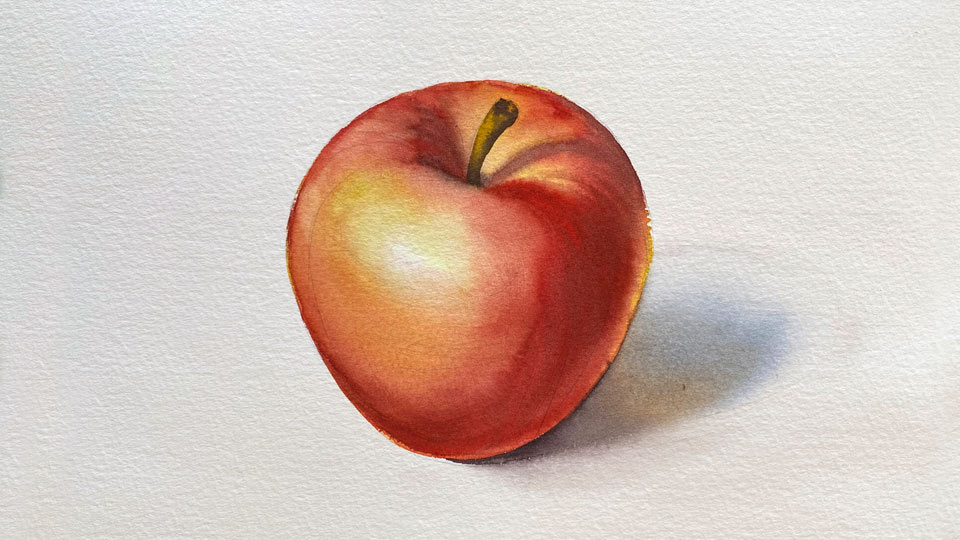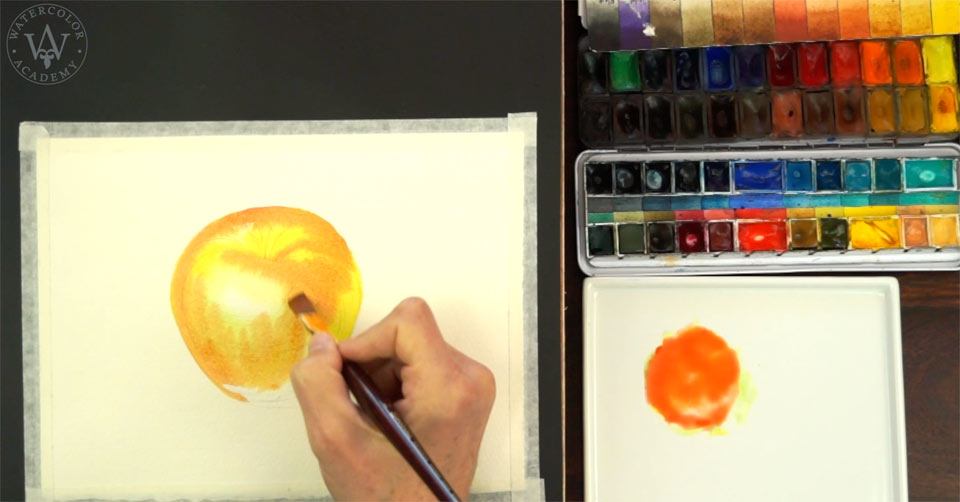A self-study, self-paced course where you can learn how to paint in watercolor by watching video lessons and doing assignments
$297 USD
ENROLL NOWA self-study, self-paced course where you can learn how to paint in watercolor by watching video lessons and doing assignments
$297 USD
ENROLL NOWOne-to-one, unlimited and custom-tailored to your skills and needs Personal Tutoring by the Watercolor Academy teachers
$997 USD
ENROLL NOWVideo lesson by Vladimir London
In this video lesson, you will discover how to paint in watercolor using the 'wet-into-wet alla prima' technique.As the name of this technique suggests, I will paint on the wet paper surface. This is why I begin this artwork by moistening the paper with clean water. For the purpose of this video lesson, I will depict the same object as in previous video lessons about watercolor painting techniques – an apple. The sketch in graphite pencil is already in place, so I can begin painting in color. The process will go from light to dark tones.

I made the first layer in light yellow, painting it wet-into-wet with a flat, natural hair paintbrush from Escoda. The reason that I am using a flat brush is because it holds less water than the same width round brush. Keeping control of how wet the brush is, is very essential for this watercolor painting technique. Because the paint mix is applied wet-into-wet, more water is added on the paper surface with every brush stroke. If the paper becomes oversaturated with water, the paint may run uncontrollably. After the first yellow layer, I add the red pigment into the mix, allowing me to paint warmer colors and darker tonal values. I apply this mix on top of the previous layer, which is still wet, therefore, painting wet paint onto the wet surface. This is exactly what the name of this painting technique is about – 'wet-on-wet alla prima'. Now, I am making an even warmer and darker mix, by adding another darker, red pigment onto the palette. I am painting the red stripy pattern on the apple skin using separate brush strokes; I am doing this with the corner of the flat brush in order to make the brush strokes thinner. As you can see, those brush strokes stay in place without spreading too much on the wet paper surface. Of course, their borders are soft because I am painting wet-into-wet. However, the paint stays in place without running down in streams.

Because this is alla prima, I intend to finish this quick artwork in one session, whilst the paint is wet. As you may remember, in the previous lesson, I also produced an alla prima artwork. However, there is a fundamental difference between these two painting techniques: 'wet-on-dry alla prima', which I did in the previous lesson, and 'wet-into-wet', which I am doing now. Both techniques are alla prima, which means that the artwork has to be done from the first attempt. But this is where the similarity ends.
When painting 'wet-on-dry alla prima', every new brush stroke is applied onto the dry surface Such strokes are slightly overlapping the previous neighboring brush strokes, in order to diffuse the borders between strokes and continue seamless gradations of colors and tones. Every brush stroke has to be applied in full strengths and in the right color, because it will stay as is without any alterations or painting over. This is what makes the 'wet-on-dry alla prima' technique so special.
However, in this video lesson, I am painting 'wet-into-wet alla prima'. This is a more flexible way of making rapid watercolor sketches, as well as bigger scale and longer artworks. Because this technique is produced 'wet-into-wet', I have the luxury of coming back to already-painted areas, in order to add more paint and gradually build up tonal values and increase the saturation of colors. Even though I can add more pigment onto the same area, I am not painting in glazing layers, because I am simply adding more paint into one wet layer. This is a direct method of painting, which is called that way because I am mixing different pigments directly with each other, either onto the palette or onto the paper surface.
I have to say that an artist very seldomly uses just one alla prima painting technique to make an artwork: either 'wet-on-dry' or 'wet-into-wet'. In most cases, there will be a combination of different watercolor painting techniques. Nevertheless, for the purity of demonstrating just one painting method in a video lesson, every apple artwork presented here is done in just one technique.
When it comes to alla prima, I also have to mention that this is the technique of choice by children and unprofessional watercolor enthusiasts, as well as by professional watercolor artists. This is because this technique is very straightforward and easy to understand, just like taking the right color and applying it in the right place! Of course, such simplicity is deceptive. That is why the Watercolor Academy course teaches you so much more, including the color theory, art materials, the right way of mixing pigments, artwork composition and much more!
A self-study, self-paced course where you can learn how to paint in watercolor by watching video lessons and doing assignments
One-time payment - Lifetime membership
$297 USD
One-to-one, unlimited and custom-tailored to your skills and needs Personal Tutoring by the Watercolor Academy teachers
One-time payment - Lifetime membership
$997 USD